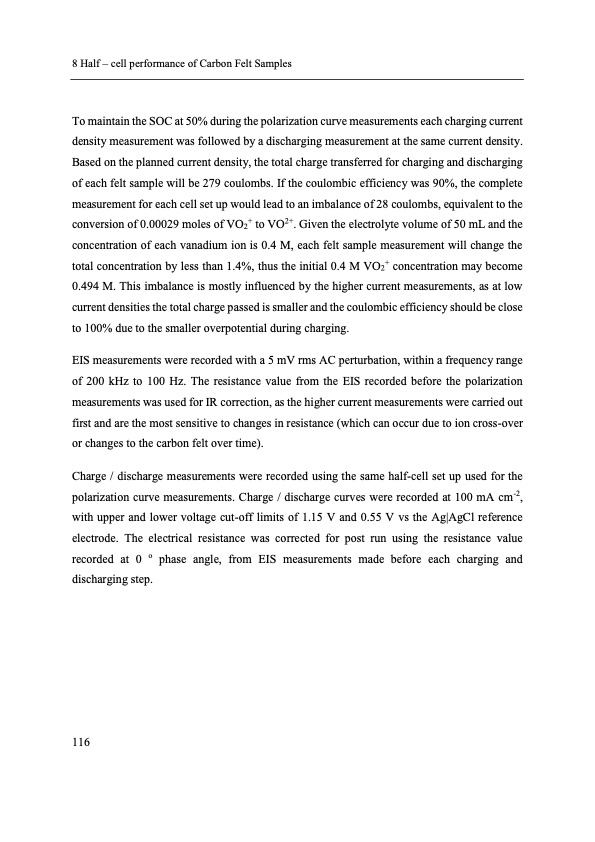
PDF Publication Title:
Text from PDF Page: 128
8 Half – cell performance of Carbon Felt Samples To maintain the SOC at 50% during the polarization curve measurements each charging current density measurement was followed by a discharging measurement at the same current density. Based on the planned current density, the total charge transferred for charging and discharging of each felt sample will be 279 coulombs. If the coulombic efficiency was 90%, the complete measurement for each cell set up would lead to an imbalance of 28 coulombs, equivalent to the conversion of 0.00029 moles of VO2+ to VO2+. Given the electrolyte volume of 50 mL and the concentration of each vanadium ion is 0.4 M, each felt sample measurement will change the total concentration by less than 1.4%, thus the initial 0.4 M VO2+ concentration may become 0.494 M. This imbalance is mostly influenced by the higher current measurements, as at low current densities the total charge passed is smaller and the coulombic efficiency should be close to 100% due to the smaller overpotential during charging. EIS measurements were recorded with a 5 mV rms AC perturbation, within a frequency range of 200 kHz to 100 Hz. The resistance value from the EIS recorded before the polarization measurements was used for IR correction, as the higher current measurements were carried out first and are the most sensitive to changes in resistance (which can occur due to ion cross-over or changes to the carbon felt over time). Charge / discharge measurements were recorded using the same half-cell set up used for the polarization curve measurements. Charge / discharge curves were recorded at 100 mA cm-2, with upper and lower voltage cut-off limits of 1.15 V and 0.55 V vs the Ag|AgCl reference electrode. The electrical resistance was corrected for post run using the resistance value recorded at 0 o phase angle, from EIS measurements made before each charging and discharging step. 116PDF Image | Electron Transfer Kinetics in Redox Flow Batteries

PDF Search Title:
Electron Transfer Kinetics in Redox Flow BatteriesOriginal File Name Searched:
electron-transfer-flow-batteries-thesis.pdfDIY PDF Search: Google It | Yahoo | Bing
Salgenx Redox Flow Battery Technology: Salt water flow battery technology with low cost and great energy density that can be used for power storage and thermal storage. Let us de-risk your production using our license. Our aqueous flow battery is less cost than Tesla Megapack and available faster. Redox flow battery. No membrane needed like with Vanadium, or Bromine. Salgenx flow battery
| CONTACT TEL: 608-238-6001 Email: greg@salgenx.com | RSS | AMP |